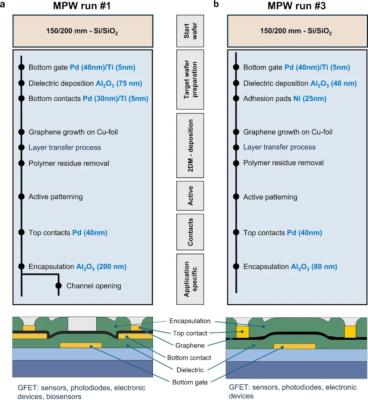Researchers from AMO, Graphenea and RWTH Aachen University have, as part of the European experimental pilot line for electronic and optoelectronic devices based on graphene and related two-dimensional (2D) materials, namely the Experimental Pilot Line (2D-EPL) project, reported the results obtained during the first and third multi-project wafer (MPW) runs completed at the end of 2022 (MPW run 1) and 2023 (MPW run 3).
The Experimental Pilot Line (2D-EPL) project, that aims to advance the widespread commercialization of electronic devices based on graphene, published the new report that summarizes the results of two multi-project wafer (MPW) runs, utilizing electrical and spectroscopic characterization to demonstrate the high quality of production in the 2D-EPL. MPW run 1 was intended mainly for graphene-based sensors, in particular chemical and biosensors, while MPW run 3 focused on graphene electronics.
Prior to the runs, specification sheets, including performance parameters such as carrier mobility, charge neutrality point, sheet resistance and contact resistivity were shared with potential customers. Fabricated wafers were delivered to the customer only when target values were reached. Aside from these parameters that were relevant for the customers who ordered single chips from the wafer, uniformity across the wafer was also measured, because that parameter is of importance for industrial processes.
The potential customers first enrolled through a universal 2D-EPL access page and then received a process design kit with information on available materials, fabrication methods, and design rules. All the customers’ designs were combined into a common lithography mask design, which also included test dies with reference devices spread evenly across the wafer.
The two runs received 60 applications from potential customers from nearly all continents, including universities, start-ups, small and medium enterprises and large industries. Application areas included electronic devices, bio and terahertz sensors, and photodetectors.
Raman spectroscopy indicated high graphene quality, with a very small defect peak in the spectrum. Notably, there was no change in the intensity of the defect peak before and after graphene processing, which indicates that the production process maintains the high quality of the graphene layer. The electrical properties were also excellent and well within the specifications, whereas the fabrication yield was very high, 94% for MPW run 1 and 87% for MPW run 3.
These encouraging results were achieved with financial support of the European Commission, with a total of 20 million euros between 2020 and 2024. The 2D-EPL emerged from the Graphene Flagship project with the purpose of addressing challenges in fabrication of graphene devices and establishing the first experimental pilot lines for prototype production of graphene and related 2D material-based electronics, photonics and sensors on a wafer scale.
The results of the report indicate that the 2D-EPL platform is a promising one for prototyping graphene devices, for individual small customers as well as for larger industry. Several challenges and issues to be addressed have also been discovered during the process and described in the paper.


